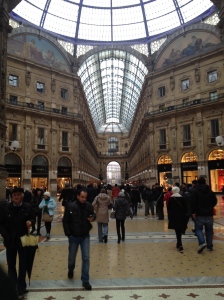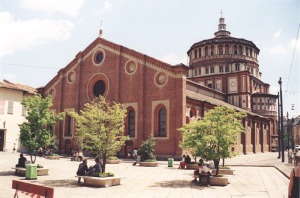In Brittany Wade
Milan is the second largest city in Italy and the fifth largest city in the European Union. As a part of the Blue Banana (or European Backbone), it is considered to be one of the most populous, affluent, and industrial urban areas in the world. Known as one of the top fashion and design capitals on the world stage, Milan’s shopping district surrounding the Via Torino and Galleria Vittorio Emanuele II are on par with the Champs Élysées and Rodeo Drive. As well as being a commercial and financial center of Europe, Milan is one of the most highly established intellectual and cultural hubs in Italy.
I did not know much about this great city before I ventured there during the Christmas holidays, assuming I would just wander through some outdoor markets, check out a couple of churches, and take it easy. I had not expected to encounter such a vast array of artistic, architectural, and culturally stimulating activities that I could devote my time to. Everything is easily accessible by underground metro or bus and (to my surprise) tickets are reasonably priced. Unlike the other three cities I visited in Italy, most of the museums offer student discounts and churches are free to enter (although there will be a small fee for roof access and taking pictures; example: Duomo di Milano).
My greatest surprise came from the Palazzo Reale where two of my favorite artists had world renowned exhibitions taking place. The first exhibition simply entitled Warhol was a compilation of 160 paintings, sculptures, and photographs by American Pop Artist, Andy Warhol, collected and created by his close friend Peter Brant. It displays some of his most iconic works such as the silk-screened Marilyn Monroe and Mona Lisa, polaroids of his celebrity friends, and the legendary Campbell’s soup can.
The second exhibition was entitled Pollock & the Irascibles which held works by American artist Jackson Pollock and other abstract expressionist painters from the “irascible” movement. It was fantastically curated to convey the creative process of expressionist painting through film along side the finished masterpieces. In the middle of the first room, a circular couch with head cushions was placed to view a film on the ceiling showing Pollock flinging paint in his signature style on to a piece of glass. This created an experience for the viewer that was both interactive and bonding with the works that they were about to see. The tickets for both exhibitions had student discounts and included audio guides that ensured you got the most out of your visit.
The most moving part of my Milanese experience however was getting to see Leonardo da Vinci’s The Last Supper. Located in its original location in the UNESCO World Heritage Site of Santa Maria delle Grazie, the painting has had a lifetime of conservational issues. Da Vinci had constructed the work using a “dry” technique to prolong his painting process; while this was ideal for the nuances and detail he wished to convey, it caused the colors to fade and the plaster to deteriorate much more quickly. Five restorations have taken place since the 18th century, the latest one taking up to 20 years to complete (1970-1999 by Pinin Brambilla Barcilon). The painting receives regular maintenance by specialists, undergoing scheduled inspections and “dustings”.
To be able to see the masterpiece becomes more of a privilege than a right, with tickets needing to be reserved far in advance for a 15 minute viewing slot and with no more than 20 people at a time. Two air-locked chambers are on either side of the chapel that houses the painting, limiting pollutants and light brought in by the visitors coming and going. The chapel has been climate controlled and the original windows which cast the light depicted by the artist have been blocked off. A guide enters with you and gives you a brief history and reading of the work before you can take it in on your own. It was powerful knowing that such devotion is involved in protecting one of the most famous works of art in human history and it was an experience I will treasure forever.
These are just a few examples of the cultural sites that I saw during my time in Milan and there are countless more that the city has to offer. The combination of great food, hospitality, entertainment, and culture makes Milan a must-see if you are ever visiting Northern Italy.
Milan: far more than just great shopping
Milan is the second largest city in Italy and the fifth largest city in the European Union. As a part of the Blue Banana (or European Backbone), it is considered to be one of the most populous, affluent, and industrial urban areas in the world. Known as one of the top fashion and design capitals on the world stage, Milan’s shopping district surrounding the Via Torino and Galleria Vittorio Emanuele II are on par with the Champs Élysées and Rodeo Drive. As well as being a commercial and financial center of Europe, Milan is one of the most highly established intellectual and cultural hubs in Italy.
I did not know much about this great city before I ventured there during the Christmas holidays, assuming I would just wander through some outdoor markets, check out a couple of churches, and take it easy. I had not expected to encounter such a vast array of artistic, architectural, and culturally stimulating activities that I could devote my time to. Everything is easily accessible by underground metro or bus and (to my surprise) tickets are reasonably priced. Unlike the other three cities I visited in Italy, most of the museums offer student discounts and churches are free to enter (although there will be a small fee for roof access and taking pictures; example: Duomo di Milano).
My greatest surprise came from the Palazzo Reale where two of my favorite artists had world renowned exhibitions taking place. The first exhibition simply entitled Warhol was a compilation of 160 paintings, sculptures, and photographs by American Pop Artist, Andy Warhol, collected and created by his close friend Peter Brant. It displays some of his most iconic works such as the silk-screened Marilyn Monroe and Mona Lisa, polaroids of his celebrity friends, and the legendary Campbell’s soup can.
The second exhibition was entitled Pollock & the Irascibles which held works by American artist Jackson Pollock and other abstract expressionist painters from the “irascible” movement. It was fantastically curated to convey the creative process of expressionist painting through film along side the finished masterpieces. In the middle of the first room, a circular couch with head cushions was placed to view a film on the ceiling showing Pollock flinging paint in his signature style on to a piece of glass. This created an experience for the viewer that was both interactive and bonding with the works that they were about to see. The tickets for both exhibitions had student discounts and included audio guides that ensured you got the most out of your visit.
The most moving part of my Milanese experience however was getting to see Leonardo da Vinci’s The Last Supper. Located in its original location in the UNESCO World Heritage Site of Santa Maria delle Grazie, the painting has had a lifetime of conservational issues. Da Vinci had constructed the work using a “dry” technique to prolong his painting process; while this was ideal for the nuances and detail he wished to convey, it caused the colors to fade and the plaster to deteriorate much more quickly. Five restorations have taken place since the 18th century, the latest one taking up to 20 years to complete (1970-1999 by Pinin Brambilla Barcilon). The painting receives regular maintenance by specialists, undergoing scheduled inspections and “dustings”.
To be able to see the masterpiece becomes more of a privilege than a right, with tickets needing to be reserved far in advance for a 15 minute viewing slot and with no more than 20 people at a time. Two air-locked chambers are on either side of the chapel that houses the painting, limiting pollutants and light brought in by the visitors coming and going. The chapel has been climate controlled and the original windows which cast the light depicted by the artist have been blocked off. A guide enters with you and gives you a brief history and reading of the work before you can take it in on your own. It was powerful knowing that such devotion is involved in protecting one of the most famous works of art in human history and it was an experience I will treasure forever.
These are just a few examples of the cultural sites that I saw during my time in Milan and there are countless more that the city has to offer. The combination of great food, hospitality, entertainment, and culture makes Milan a must-see if you are ever visiting Northern Italy.

Brittany Wade is the editor of the Initiative for Heritage Conservancy blog and student of the MA in Heritage Management 2013. Having studied Classics in her undergraduate, Brittany is interested in applying her knowledge of history in the field of archaeology. Her interests are mainly in Prehistoric Minoan and Hellenic history.
very hairy pussy https://www.instagram.com/hairyhousewife/ very hairy pussy and crotch






anna mosca
Jan 06, 2014 at 12:37 amI agree! Thank you.